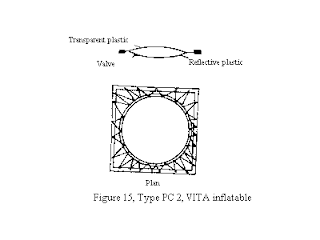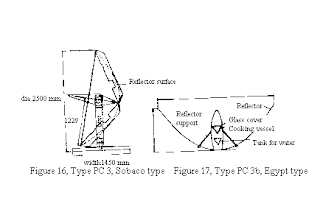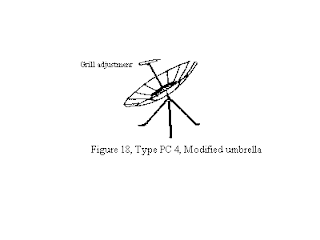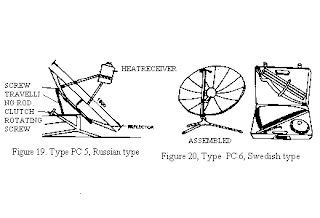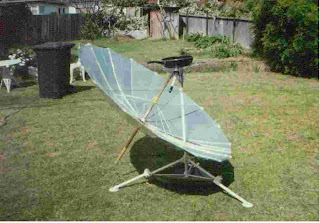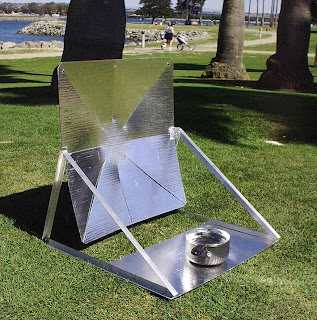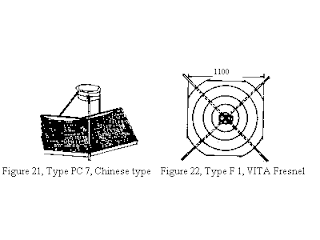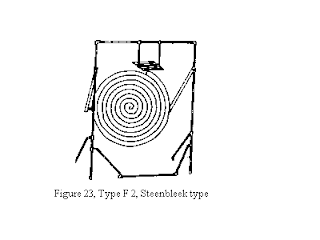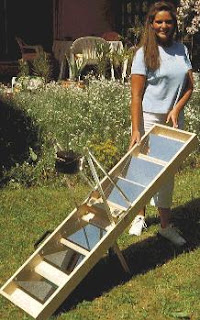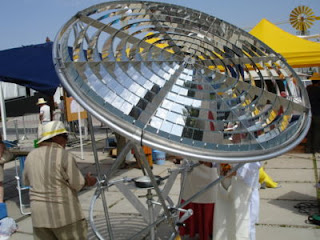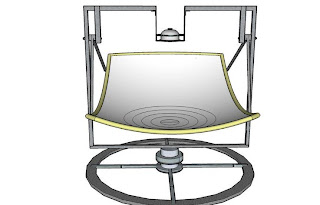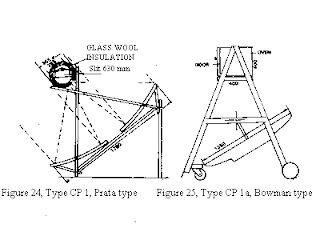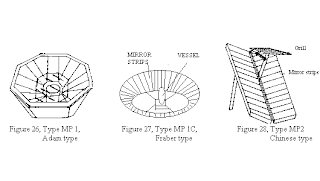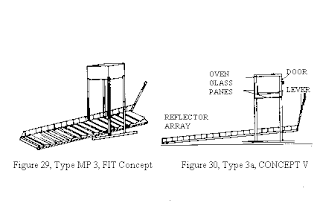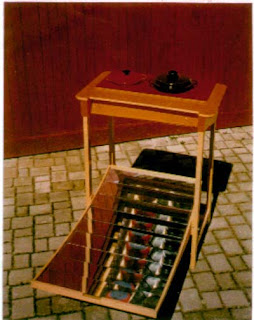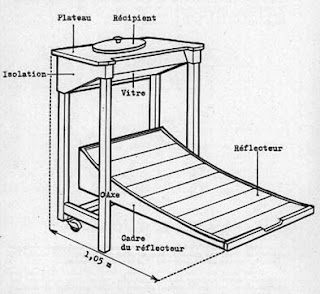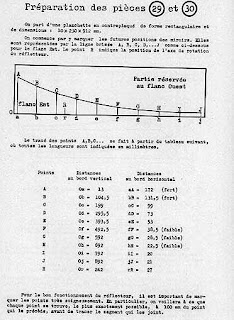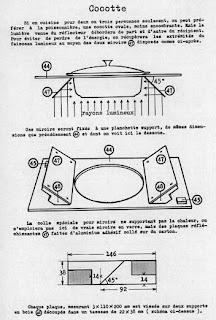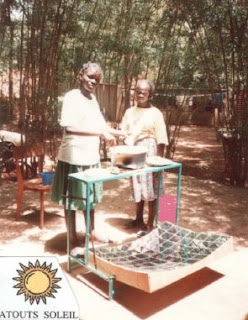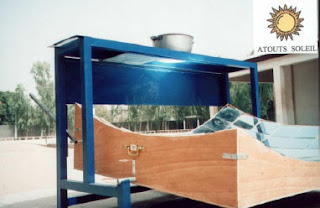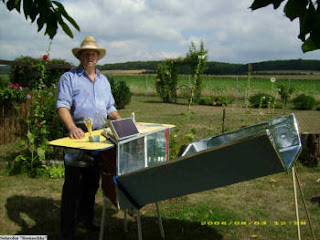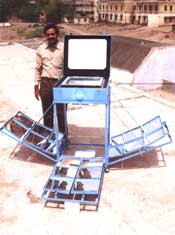Parabolic Concentrators
2
Collapsible Parabolas/
Fresnel reflectors
/Cylindro Parabolic/Plane Mirrors
Parabolic reflectors
were bulky and were difficult to transport and hence collapsible concentrators
were designed. A Swedish design, called Umbryoler, was probably one of the
first designs to emerge on the scene (PC 1, Figure 14). It was mainly designed
with campers in mind, and the unit would open out as an umbrella. The reflector
was made from sheets of aluminized polyester or sheets. Fluttering focus and
unstable mirror were the chief drawbacks of this otherwise good looking designs
( Annon 1981a ). Chinese ( Fang, Susan 1979 ) and Japanese designs (PC 1b) are
variations of this design. In 1961, the VITA group tried out another
interesting design, the famous inflatable concentrator (VITA 1961). Though it
had a checkered history the design is still in vogue and, recently, it has
appeared again with more firm materials in solar water pump application (Beale
1981) . Basically, the reflector is a large round aluminized polyester sheet of
slightly thicker gauge, over which another clear polyester sheet was fused all
along the edge. When this assembly was tightly but evenly stretched and tied
between a frame and inflated, a Perfect parabolic reflector was formed (Figure
15). Fluttering focus was the main drawback.
Source:- TIDE.,
March 1998, 8-1, pp 1-37,
For Comments,
suggestions, contributions contact
Please add,
Solar or Solar Cooker, in the subject to avoid your
mail being erased as scam
Sobako (Type PC 3,
Figure 16) was an ingenious design from Germany. It was a foldable parabola
with a stainless steel reflector. When opened, the reflector focused the sun’s
rays at the base of a copper plate housed in a doubly glazed glass box. The
area of the reflector was about 0.75 sq. m. Kanua (1979) has worked extensively
on this design and finds that the glass box broke often, and difficulties were
encountered while folding the reflector. He suggests many modifications but it
is felt that unless the reflector area is increased the unit may not perform
well. Egypt cooker is another design based on similar principles (Type PC 3b,
Figure 17), Here, the reflector was a cylindrical parabolic mirror. A specially
designed 5 liter box was fixed at the center for holding the cooking vessels
but the German group found the unit rather bulky, and maximum temperature
attainable was only 180oC. This German group evolved a similar but
smaller cooker where the triangular box is hosed in the glass box.
The modified umbrella
(PC 4) is, in fact, nothing but an umbrella with an aluminized polyester sheet
stuck to the concave side of it. Though modified design, the reviewer still
considers it as a main type for it converts an ordinary umbrella into a solar
cooker. Recently, there were some reports that this design was getting popular
in north India (Figure 18). As seen in Figure 18, instead of keeping the vessel
on the grill fitted to the handle, the vessel could be placed on a fixed
platform and the umbrella adjusted to focus the sun rays which may give a
better result but cooking on a windy day could be difficult and tricky.
Umbrellas have always
enthused Solar innovators. Recent entry is by Juan Francisco Paredes. (Email: juanfranciscoparedes@gmail.com) He
has a very illustrative web site (http://club.telepolis.com/elcatamaran/barbacoa-solar/) is a must visit for all. He has
barbecued meet on it and thus showing its effectiveness. Marc Ayats (http://cuinessolars.iespana.es ) has also presented
this idea in a slightly different manner.
Barbacoa Cooker
Source:- TIDE.,
March 1998, 8-1, pp 1-37,
The Russian folding
cooker (Type PC 5, Figure 19) was probably the largest folding cooker ever
designed. It had a reflector of 1.5 sq. m in diameter. It has been designed
with lot of care to avoid flaws, as it was meant for use of Military personnel.
The rotating screw indicated that mirror adjustment was easy and the cooking
pot could be kept in an insulated receiver. It is claimed that the cooker could
double as a rain shade or tent at night.
Swedish designers
(cited by Venkatesam 1980) had come out with a very neat package of a solar
cooker that fits into a specially designed suitcase (Figure 20). It is ideal
for campers, but for day to day use the reflector has to be larger.
VITA (1961) announced
another interesting design from China (Type PC 7, Figure 21). The foldable
reflector, evidently a section of the parabola, made up of small mirror pieces,
opens out at the base of a tripod stand holding the vessel. To some extent, the
design resembles the Sobaco type described earlier.
Recently Brett White
has taken up this very useful concept. He is the first contributor to this web
page. He has infact used a Beach umbrella and this appears to perform better.
The cooker can double as a regular umbrella. For more information visit his
site. URL is provided under other links.
Brett White's design
form his site ( listed under other links) You can buy a folding cooker from him
too.
Deris, a prolific
inventor from USA has brought out another interesting Parabolic Cooker. It is
very interesting in various ways. It is 2'x2' square Parabola, collapsible at
that. It does not focus the light at the bottom of the cooking vessel, but on
the sides as indicated in the photo. He claims that it cooks food very fast.
For more details and prices you should visit his web site( please see under
links ~solar16.htm )
Deris's design form
his web site ( listed under other links) You can buy a folding cooker from him
too from USA
Mr Li-Yan Zhu and Kim
have tried their hands in designing non tracking Parabolic Concentrator. In
their beautiful site they describe the logic behind the design and present
several picturers too. Their site could be visited through Solarcooking.org.I
have mentioned about this cooker in previous section
Fresnel reflectors
Though the parabolic
reflector
was a perfect design, even good technicians, more so the villagers, found it
difficult to construct one. This was how the Fresnel reflectors gained
importance. The very first design in this category came from VITA in 1961 (Type
F 1, Figure 22). Three to four rings of masonite (hardboard like material) were
cut from a 4’ x 4’ sheet. Aluminized polyester was stuck to this. After which
the rings were nailed to specially notched wooden reapers to form a Fresnel
concentrator. VITA provided a template of these materials as it was a
do-it-yourself project (VITA 1971). The cooking pot was supported on a rod
projecting from the center. Adjustments, once in 30 minutes, were considered
sufficient. Ease of construction and focusing characteristics made this design
better than the regular parabolic reflector (VITA 1961). Prof. Garg, an Indian
designer (Garg et al 1978), suggests further improvements by making the
reflector with five to six rings.
For Comments,
suggestions, contributions contact
Please add,
Solar or Solar Cooker, in the subject to avoid your
mail being erased as scam
In a comparative study
the VITA design emerged as a top model (Garg 1978). Attracted by the simplicity
of the Fresnel geometry, Steenbleek (Type F 2, Figure 23) developed an
ingenious way of making Fresnel concentrator (strips of reflector materials,
with the width determined by using a computer) were wound in concentric circles
on a suitable support. Solar stalwarts like Edmondson (1981) claim that this
design was a boon to solar designers, reflectors of any size could be easily
fabricated. The author tried out this technique but encountered considerable
difficulty in cutting and fixing strips.
Recently Mr Ed Norman
of Peru has taken keen interest in the VITA design and has revived it. I am yet
to get the latest details from him as to the performance.
Dr Bernhard Muller of
Germany who visited my site recently, March 2003 to be precise, has directed me
to www.mueller-solartechnik.de. Here I found some more interesting variation of
Fresnel design. The Photo taken from his site gives good details. The linearly
arranged Fresnel lens focuses light on to a pot kept at the focal point, about
50 cm away from the mirrors. The design is supposed to deliver ~300W power. The
one which could deliver ~600 W is in the form of Cross says Dr Muller. He
recommends unit with Glass mirrors. The standard Cooker comes with Aluminium
Foil Reflector.
Fatangre's ( 1992 )
design is actually a Box type design wherein he incorporates a transparent
Fresnel lens in the lid of the Gosh type box.
Another interesting
Fresnel arrangement has been described by Bob Culbertson,of US, in which an
array of flat mirrors are lined up which focus the sun rays at the bottom. The
configuration could be described with the help of forward and backward slashes.
This I guess works and it may be easy to divert the focused rays to the base of
a pot.
* ( Sun )
\\\\\\\\
\///////////
+ ( focus)
The above concept has
been presented by an Unknown Inventor(at least till now) at International
Conference on Solar cookers held at Granada in 2006. The cooker has circular
arrangement of reflectors which direct the focus below the umbrella like
holder. I would call it Fresnel Umbrella. The focus is being used directly, but
I feel it would be better and much more convenient to divert the focus to the
bottom of the vessel. In which case the Fresnel Umbrella can be 'hung' over
suitable 'sunny' window, and focus diverted inside home to cook food from the
comforts of kitchen/room.
Mr Magnar Totland,
hailing from beautiful Norway, but now settled in Congo and helping out there,
has found time to launch a excellent site on Solar cookers with superb
rendering. His site has Parabolic reflectors of various types, Conical Cookers
and Box cookers. It is one of the best sites ever, and I urge the reader to
visit his site at (http://solarcookers.ning.com. His design discussed here can
be classified as Semi-fresnel Cocentrator, has other designs will be discussed
under respective sections. The concentrator proper is rectangular parabolic
reflector, and probably to get a better focus concentric Fresnel arrangement
has been incorporated in the center. The reflector is mounted on a sturdy stand
and good provision is made for cooking vessel as well.
These are an interesting
class of concentrators used mostly in water heating applications, but the very
first design using such mirrors was that of Prata (1961) (Type CP 1, Figure
24). The cylindro-parabolic concentrator focused the rays into an insulated
cylindrical box in which two or more cooking vessels could be accommodated
(Fraber et al. 1975). Bowman, who built and tested the design, encountered
several difficulties (Bowman, Blatt 1978), and he tried to improve upon the
design. This resulted in a series of new concepts. The FIT concept No. 1, (Type
CP la, Figure 25) is almost similar to Prata’s design but it has only a single
cylindro-parabolic swinging reflector.
Source:- TIDE.,
March 1998, 8-1, pp 1-37,
For Comments,
suggestions, contributions contact
Please add, Solar or Solar Cooker, in the subject to avoid your mail being erased as scam
Another improvement
development was the incorporation of a bigger and easy-to-use insulated box to
house the cooking vessel. Results were slightly better. Reddy (1980) has
presented a similar design.
The Edmond Scientific
Supplies Company (Type CP2) was selling yet another design of this category
mainly meant for warming food; it was basically a styrofoam parabola with
aluminized polyester (Warenham 1995).
Another very recent
cooker presented here has been taken from BBC online. ( BBC Online . This is
being classified by me under this section of Cylindro parabola. I quote from
their site as follows: "The solar sausage sizzler is a bit more tricky to
make and watch out for all of those cocktail sticks. However, once built it
makes short work of a sausage or two (we used Frankfurters sausages). Have a
go, and let us know if you succeed" . Further details can be obtained from
their site
Plane mirrors were also
in vogue in solar cooking but it was Adams who, in 1870, built a cooker at
Bombay (Type MP 1, Figure 26) (Bowman, Blatt 1978). He was able to cook food
for several soldiers. The cooker consisted of sixteen flat mirrors arranged to
form a cone around a flat black surface meant for the cooking vessel. Further,
it was covered with a glass dome with a wooden handle. Such a design was
available till recently in the market. The cooker very similar to this, called
‘Solar chef’ (Type MP la) was marketed by Sedona Solar Shop, ( PO 3072, West
Sedona, Arizona 86340, USA.) Prof. Bowman found the performance of the cooker
satisfactory. He suggested some improvements like fixing the mirror assembly on
to a stand such that it could be oriented to the sun, increasing the number and
size of the assembly as well as the central dome to accommodate bigger cooking
vessels. Insulating the flat plate at the bottom was also suggested some
improvements like fixing the mirror assembly on to a stand such that it could
be oriented to the sun, dome to accommodate bigger cooking vessels. Insulating
the flat plate at the bottom was also suggested (Type MP 1b). This variation
gave good results. Faber (1975) describes a similar design where the mirror
cone is comparatively larger (Figure 27).
The Chinese designers
(Fang, Susan 1979) have another interesting variation (Type MP 2, Figure 28).
Here, the 15-20 cm wide and 25-30 cm flat long mirror strips were arranged in a
row of 14-16 pieces. Two such rows of mirrors were hinged at the centre. These
mirrors focused the rays on to a cooking pan held on top of the grill
projecting from the center of the hinged panels. There must have been some
mechanism to tilt the mirrors, but the details were not available.
Bowman created a new
design called FIT design (Type MP. 3, Figure 29) which was an offshoot of his
studies on cookers especially CP la. He felt that flat-mirror assemblies were
the best for villagers. The cooker consisted of a solid frame to hold an
insulated box with a door to house the cooking vessels. The box did not have
insulation at the bottom but a weld – mesh. Light was focused by 15 strips of mirrors
held in a row at the base of this stand. Provision was made to tilt the mirrors
to aid in focus and this was affected with one single lever, and the frame
could also be rotated to face the sun.
For domestic use
Bowman suggests a mirror assembly of about 19 mirrors with a length of 120 cm
held at an angle of 100 to the horizontal (Bowman, Blatt 1978).
FIT concept 3 had a mirror assembly of 3 m and it could melt even lead (MP
327.50 C ). The FIT concepts described were excellent
performers and with some more adaptations like folding the reflector for easier
transportation and storing, mounting the entire assembly on bigger wheels for
easy mobility, and orientation would have made these cookers very popular.
Interestingly, such a cooker was fabricated here at the Manipal Institute of
Technology (MIT), Manipal, under a student project, but the cooker did not
perform well. The Indian Institute of Technology (IIT), New Delhi, suggests the
use of such a row of mirrors (Type MP 2a) to be kept outside the house so as to
concentrate the rays on to the vessel kept inside the house. Concept III
proposed here by the author (Type 3c) envisages the use of two rows of mirrors
as in the Chinese design and the entire assembly kept at the window. However,
depending on the location and orientation of the house, it may be essential to
shift the cooker from one window to another, in which case the design has to
incorporate features which would enable easy mobility (Type MP 3 a, Figure 30).
Concept IV proposed in this review is a variation of Bowman’s design. In this
variation, the use of a larger window covered with glass is suggested at the
base of the insulated cooking box (Figure 31) such that a larger reflector
array could be incorporated without increasing the height of the stand, but if
a 3 or 4 m long array is to be incorporated for faster cooking then the height
of the stand has to be increase. In such a case, three or four steps may be
added to the stand for easy access to the cooking vessels inside the insulated
box. Prof.
Bernard's 'NELPA'
cooker appears to be slight variation from Prof. Bowmans design, but evidently
an independent design of this type.
The photo was sent by
Prof. Bernard, note that the cooker has provision for two pots. ( I have added
a couple sketches so as to enable the reader to build a Nelpa. I thank
Editions-Jouvence.fr, Publishers from France for permitting to use these
drawings.
Prof. Bernard's 'NELPA' cooker, though I find the design very close to that of Prof. Bowman's FIT design presented above I feel 'NELPA' has been designed independently. For some reason Prof. Bowman's designs had not become popular.
'NELPA' when folded forms a
neat little 'packet'.
Mr Bernhard Muller of
Germany has modified Prof Roger Bernard's design of Nelpa and is in fact
manufacturing it in Germany and selling it all over the World. Presented here
is his design of Nelpa, called by him as "Primrose cooker" Mr Muller
can be contacted through his excellent site in Five languages at
http://www.mueller-solartechnik.com
Any person who visits
this review site would feel that it will not be possible to evolve a new
design, but new design keep on appearing and two such useful designs, and I
feel a very promising one at that, are by Xavior Devos and Atouts Soleil of
France another design by Alexander of Germany. Xavior Devos and Atouts Soleil
of France ( tablesol@yahoo.fr) present a new variation of Bowman's variation.
It could be regarded as improvement over Roger Bernard's NELPA. Variation is in
the form of a larger concentrator below the table. The two photos furnish the
design details and effectiveness of the setup. They have detailed the design in
pdf format. (http://www.solarcooking.org/Devos-cooker-description.pdf)
Alexander Safronov of Germany has proposed a very innovative design called as Romaschka
Cooker. The cooking vessel is incorporated in the table. A Flat reflector of about one meter long
reflects the sun light into the cooker box. Two additional strips of reflectors augment sun light.
The setup appears to be quite effective as the designer has been able to grill meat.
(http://www.solarcooking.org/Romaschka.htm)
Prof Ajay Chandak working at Dhule, is a versatile inventor. It is a pity I did not know about him earlier. That I guess is the problem with independent Inventors and workers. They have problem or are not so keen writhing a Technical paper, and naturally they remain unknown for a long time. I wish to list all such workers and their work in my site. If our Government or some other philanthropic Agency decide to sponsor my work, I wish to test each and every such solar cooker especially designed by ‘non technical’ workers, and maintain a detailed Data Base along with this site.
Prof Ajay is the founder president of and NGO at Dhule. The organization is called as PRINCE ( Promoters and Researchers In Non Conventional Energy, http://www.princeindia.org ) I strongly urge the reader to visit to this excellent site.
Sri. Ajay is very much technical person, and has presented a couple of papers in Seminars. Recently on 20th Sept 2006, I had the privilege of meeting him at IIT, Mumbai
Prof Ajay has developed Hybrid Solar Cooker, which I have classified as an independent Design, and designate it as MP4. It is similar to Prof. Bowman’s FIT Design, but different and one step ahead it, or for that matter Prof. Bernard’s Nelpa. I saw the design for the first time in Dev’s site. ( listed under links ~~~/solar16.htm ). Ajay writes that the performance is as good as or even better than that of Parabolic cooker. The temperature developed was so high that they had problem with the Glazing used at the bottom of the box. Further technical details are awaited.
Source:- TIDE., March 1998, 8-1, pp 1-37,
For Comments,
suggestions, contributions contact
Please add,
Solar or Solar Cooker, in the subject to avoid your
mail being erased as scam
For Comments,
suggestions, contributions
contact
Dr. Ashok
Kundapur
Email
:
